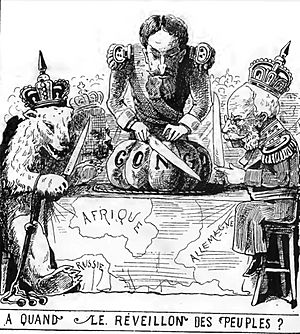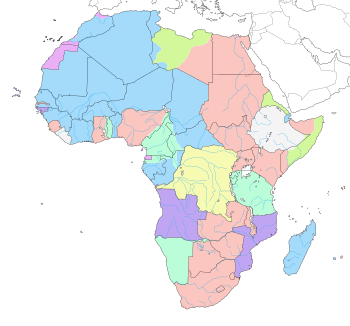Berlin Conference facts for kids
The Berlin Conference was a big meeting held in Germany from 1884 to 1885. It's also called the Congo Conference or West Africa Conference. European countries met to decide how they would divide up and control land in Africa. This happened during a time called the New Imperialism, when many powerful European nations were trying to expand their empires.
The conference was organized by Otto von Bismarck, who was the first leader of Germany. The main result of the meeting was something called the General Act of the Berlin Conference. This act officially started what is known as the Scramble for Africa. This was a period when European powers quickly took over most of Africa. They removed or ignored the existing African governments and their right to rule themselves.
Rules from the Conference
The General Act set out several important rules:
- It called for the ending of slavery. This was meant to gain public support.
- The Congo Free State became the personal property of Leopold II of Belgium. This area is now the Democratic Republic of the Congo.
- The 14 countries that signed the act agreed to allow free trade. This trade would happen across the Congo Basin and Lake Nyasa.
- The Niger River and Congo River were made free for all ships to use.
- Countries could not just claim land without actually controlling it. They had to show they had a real presence.
- If a country took over a new part of the African coast, they had to tell the other countries.
- Each European country was given specific areas in Africa that they could try to control.
Dividing Africa
The conference also helped European countries decide on their borders in Africa. Here are some of the agreements:
- Portugal and Britain: Portugal wanted to connect its colonies of Angola and Mozambique. This would have included land that is now Zambia, Zimbabwe, and Malawi. However, Britain did not agree to this plan.
- France and Britain: They drew a line from Say in Niger to Baroua near Lake Chad. France would control the land north of this line. Britain would control the land to the south. Britain also got the Nile area, while France got the Lake Chad area.
- France and Germany: They agreed on a border that gave France the land to the north and Germany the land to the south in certain areas.
- Britain and Germany: Their border went through places like Yola and Dikoa, reaching up to Lake Chad.
- France and Italy: Italy was given control over land north of a certain line, while France controlled areas to the south.
By 1902, about 90% of all the land in Africa was under European control.
What Happened Next
The Berlin Conference helped European countries avoid fighting each other over Africa. Instead, they focused their competition on taking over African lands. This led to a faster "Scramble for Africa." European powers sent groups to Africa to make local rulers sign treaties, sometimes using force. For example, Msiri, the King of Katanga, was forced to sign a treaty in 1891.
Many African states lost their independence. The French took over states in the Sahara desert. The British moved from South Africa and Egypt, conquering states like the Mahdist State. They also defeated the Zulu Kingdom and took over the independent Boer republics in South Africa.
Within a few years, almost all of Africa south of the Sahara was divided among European powers. By 1895, only a few independent states remained:
 Morocco, which later came under French and Spanish control.
Morocco, which later came under French and Spanish control. Liberia, a country founded with help from the United States for freed slaves.
Liberia, a country founded with help from the United States for freed slaves. Ethiopian Empire, the only native African state that stayed free. It fought off an Italian invasion in the First Italo-Ethiopian War.
Ethiopian Empire, the only native African state that stayed free. It fought off an Italian invasion in the First Italo-Ethiopian War. Majeerteen Sultanate and
Majeerteen Sultanate and  Sultanate of Hobyo, both in what is now Somalia, were later taken over by Italy.
Sultanate of Hobyo, both in what is now Somalia, were later taken over by Italy.
The Orange Free State and the South African Republic (Transvaal), which were Boer republics, were conquered by the British in the Second Boer War (1899-1902). Morocco was divided by France and Spain in 1911, and Libya was conquered by Italy in 1912.
By 1902, 90% of Africa was controlled by European nations.
Images for kids
See also
 In Spanish: Conferencia de Berlín para niños
In Spanish: Conferencia de Berlín para niños




